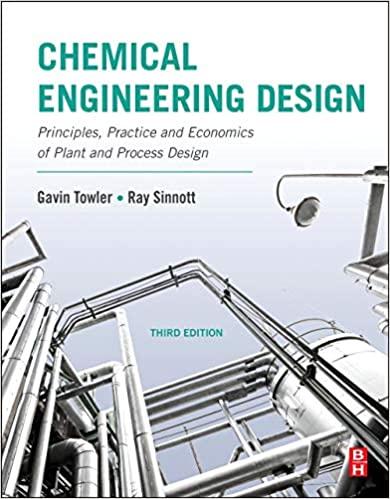A plant is required to produce 10,000 metric tons per year of anhydrous hydrogen chloride from chlorine
Question:
A plant is required to produce 10,000 metric tons per year of anhydrous hydrogen chloride from chlorine and hydrogen. The hydrogen source is impure: 90 mol% hydrogen, balance nitrogen.
The chlorine is essentially pure chlorine, supplied in rail tankers. The hydrogen and chlorine are reacted in a burner at 1.5 bar pressure:
![]()
Hydrogen is supplied to the burner in 3% excess over the stoichiometric amount. The conversion of chlorine is essentially 100%. The gases leaving the burner are cooled in a heat exchanger.
The cooled gases pass to an absorption column where the hydrogen chloride gas is absorbed in dilute hydrochloric acid. The absorption column is designed to recover 99.5% of the hydrogen chloride in the feed.
The unreacted hydrogen and inerts pass from the absorber to a vent scrubber where any hydrogen chloride present is neutralized by contact with a dilute, aqueous solution of sodium hydroxide. The solution is recirculated around the scrubber. The concentration of sodium hydroxide is maintained at 5% by taking a purge from the recycle loop and introducing a make-up stream of 25% concentration. The maximum concentration of hydrogen chloride discharged in the gases vented from the scrubber to atmosphere must not exceed 200 ppm by volume.
The strong acid from the absorption column (32% HCl) is fed to a stripping column where the hydrogen chloride gas is recovered from the solution by distillation. The diluted acid from the base of this column (22% HCl) is recycled to the absorption column.
The gases from the top of the stripping column pass through a partial condenser, where the bulk of the water vapor present is condensed and returned to the column as reflux. The gases leaving the column will be saturated with water vapor at 40°C.
The hydrogen chloride gas leaving the condenser is dried by contact with concentrated sulfuric acid in a packed column. The acid is recirculated over the packing. The concentration of sulfuric acid is maintained at 70% by taking a purge from the recycle loop and introducing a make-up stream of strong acid (98% H2SO4).
The anhydrous hydrogen chloride product is compressed to 5 bar and supplied as a feed to another process. Using the information provided, calculate the flow rates and compositions of the main process streams, and draw a flowsheet for this process. All compositions are wt%, except where indicated.
Step by Step Answer:






